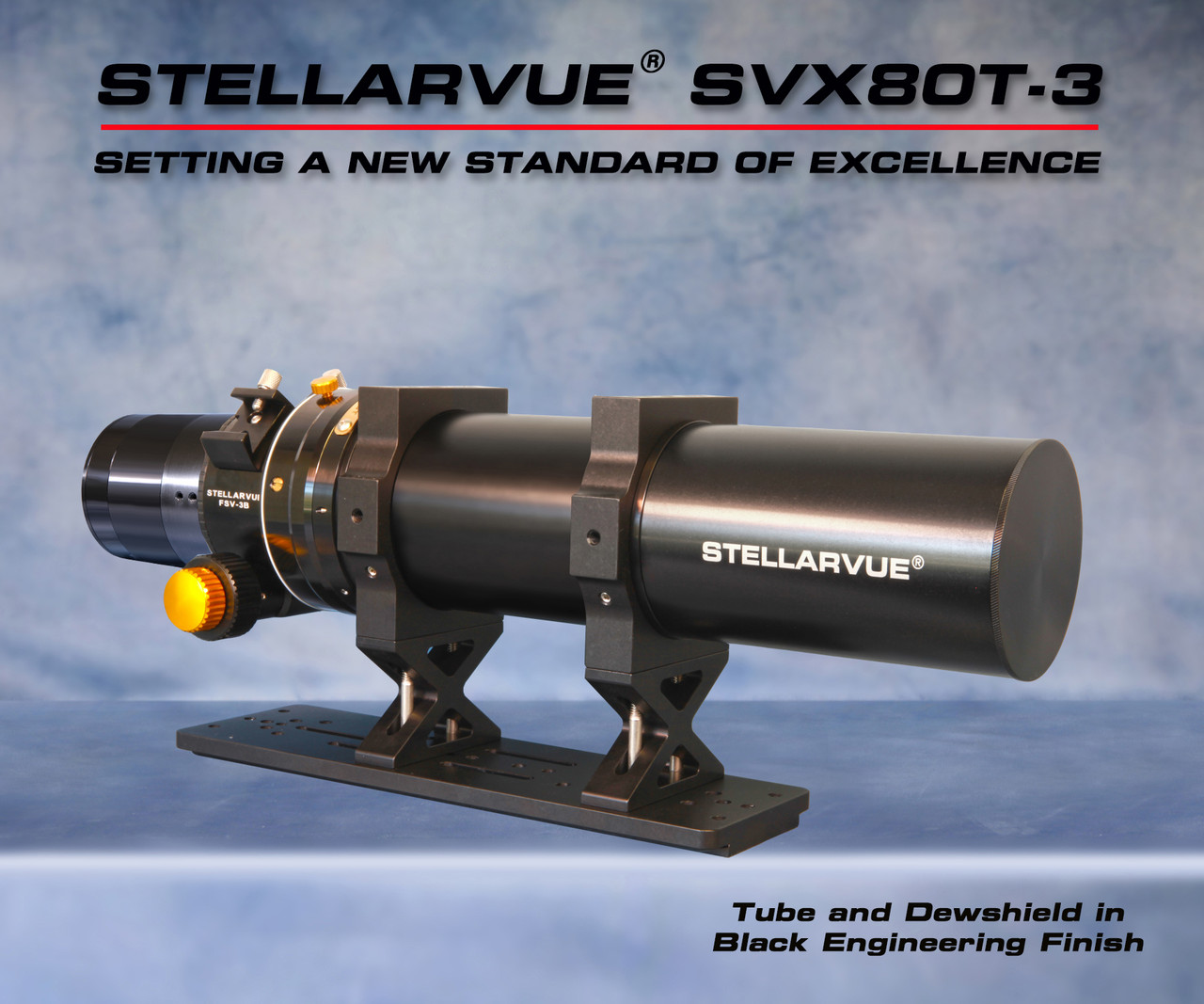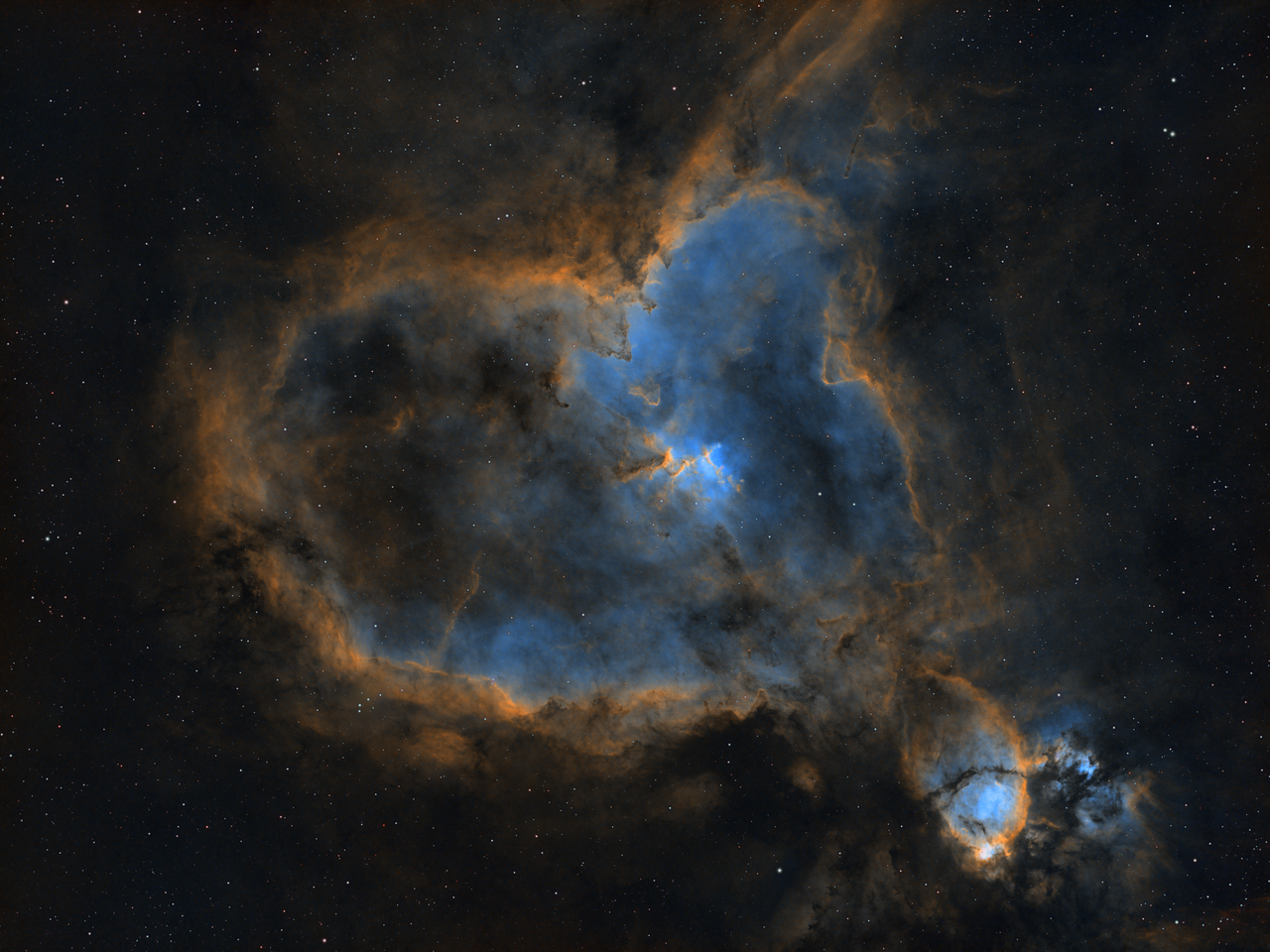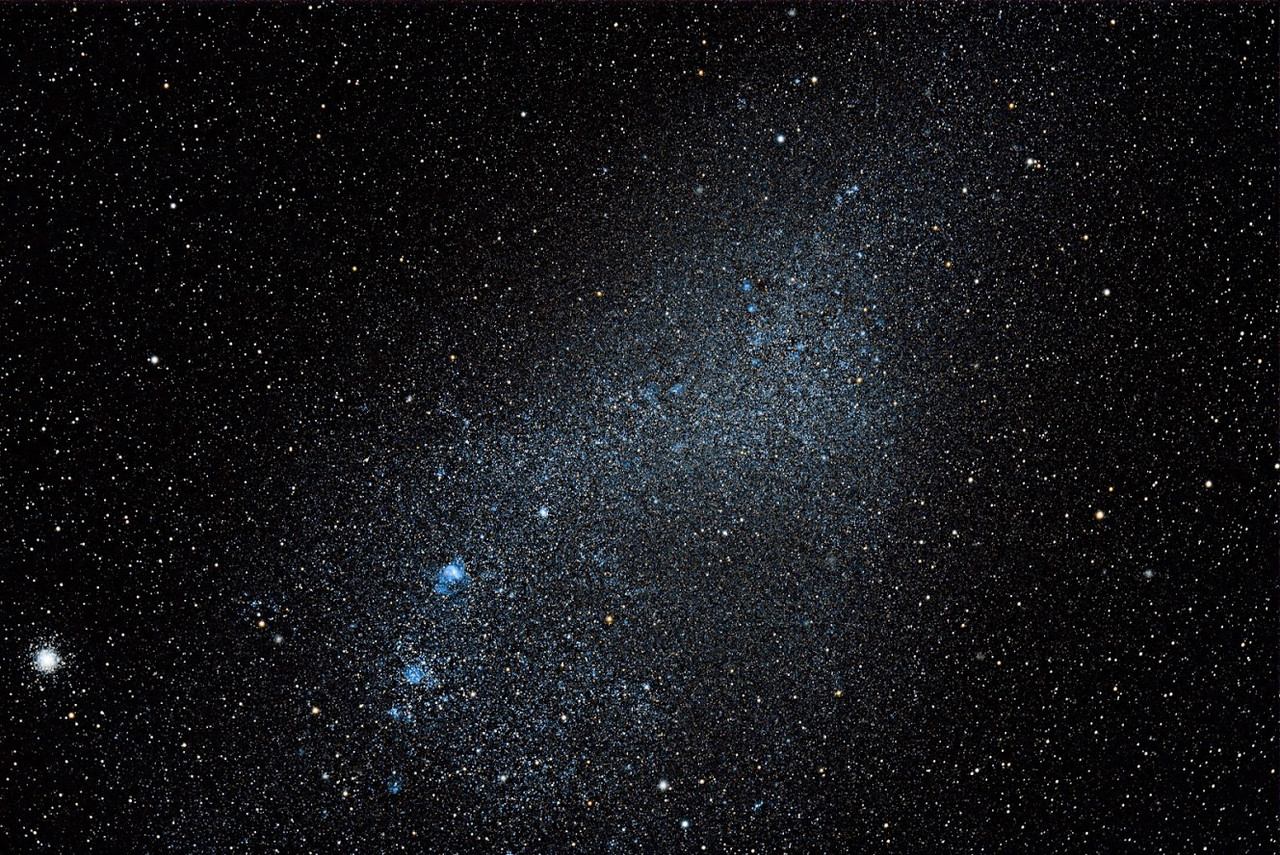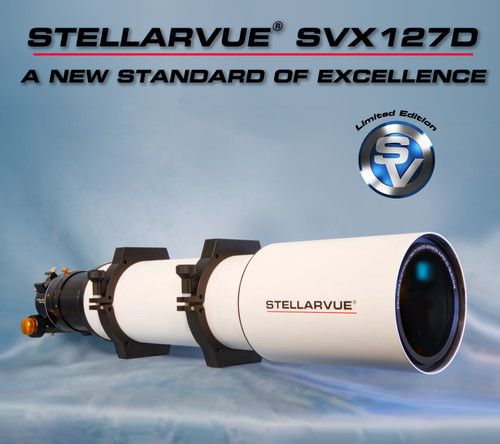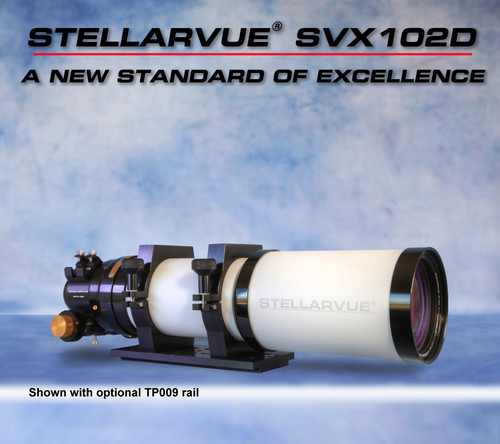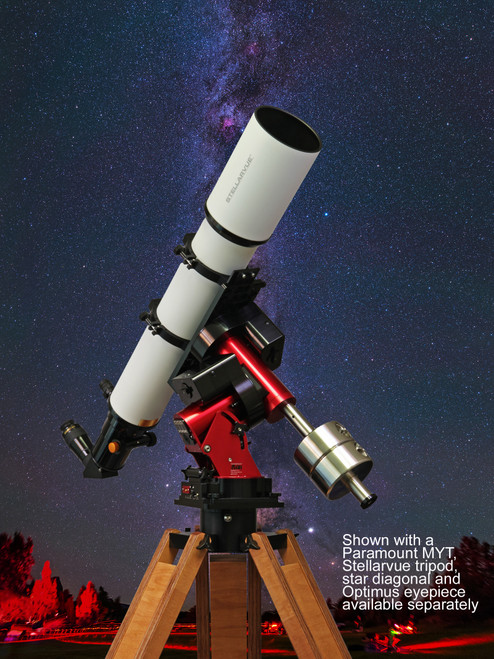Product Description
The Stellarvue SVX080T features an 80 mm f-6 (480 mm focal length) fully multi-coated, 3-element objective lens with a super low dispersion center element. To attain our high level of optical accuracy, Stellarvue opticians meticulously figure objectives in our shop using our Zygo Phase-shifting Laser Interferometer. Once all the aberrations have been reduced we center the correction in green light. The telescope comes with a Zygo Interferometric Test Report taken in red light at 97 Strehl or better. This telescope comes standard with our highly rated 3" Stellarvue dual-speed rack and pinion focuser.
Waiting Period: This telescope is now available when ordered with the standard Stellarvue focuser. If ordered with the Feather Touch or Moonlite focusers there may be a delay as these focusers are sometimes backordered. Call us if you have any questions: (530) 823-7796.
Basic Version: This of our 80 mm Apo Triplet. It Includes:
- Our Stellarvue 3" focuser with 2" and 1.25" visual adapters
- Solid one-piece rings that are bolted to the tube to eliminate felt flexure.
- C020 case to hold the telescope with rings and rail.
- Our Stellarvue 3" focuser with 2" and 1.25" visual adapters
- Solid one-piece rings that are bolted to the tube to minimize tube flexure.
- Risers so the telescope is placed above the mount so a camera will fit.
- A long rail to assist in balancing.
- C019 Case to hold the assembled telescope with risers and rail attached.
- The SFFX-1 field flattener that is essential for photographic imaging.
Each lens uses extreme broadband coatings on each surface enhance it even further. The stars appear vivid and the background, velvet black. Since these coatings transmit more than 99% in and beyond the visual spectrum, reflections seen on CCD images are eliminated.
Tube and dew shield: This telescope comes with an aluminum tube and dew shield that is precision machined, tumbled and black anodized. The inside of the main tube assembly is painted "Ultra-flat Black" and the focuser is baffled with ridges to minimize tube wall reflections. Fittings are black anodized aluminum. The dew shield retracts, reducing the length of the telescope for storage. Extending the dew shield minimizes dewing of the objective at night and serves as a glare shade during the daytime.
Risers and Rail for use with a Camera (Imaging Version Only): When adding a camera, a rail must be added to slide the system forward in order to counterbalance the additional weight. Risers allow the camera to rotate without running into the rail.
 Rings: Solid 6061-T6 aluminum rings bolted directly to the tube to eliminate any felt flexure. This is unique to the telescope. Each ring has a total of 12 1/4-20 threaded holes placed on four sides to facilitate the addition of controllers, guidescopes, handle and other accessories.
Rings: Solid 6061-T6 aluminum rings bolted directly to the tube to eliminate any felt flexure. This is unique to the telescope. Each ring has a total of 12 1/4-20 threaded holes placed on four sides to facilitate the addition of controllers, guidescopes, handle and other accessories.
Field Flattener for Imaging (Imaging Version Only): The SFFX-1 flattener included in the purchase price of the telescope is optimized to work with DSLR cameras that have an over-sized 48 mm t-ring. This modular flattener can be used with various optional adapters, making it compatible with CCD and CMOS cameras that may have a different back-focus. The SFFX-1 attaches directly to the draw tube by unthreading the 2" visual back and threading the SFFX-1 in its place.
If your camera has a different back-focus, call us at (530) 823-7796 and we will advise you on what you need to use this flattener with your camera. In most cases, we can also modify the flattener so it will work with your particular camera, eliminating the need to purchase expensive custom adapters.
For visual use, the Stellarvue Optimus eyepieces and our 2" quartz mirror star diagonal are recommended.
Two-year warranty and Stellarvue service: Stellarvue telescopes and accessories are covered by a two-year warranty. After warranty expires, Stellarvue can repair your telescope if it is damaged for a nominal fee.
SPECIFICATIONS:
Objective Lens: 80 mm f-6 480 mm focal length Apo Triplet
Optical tube length: 18" when focuser is racked in.
Focuser: Stellarvue 3" focuser with heavy duty dual-speed rack and pinion mechanism, 2" and 1.25" compression ring adapters. Threaded to accept field flattener. Optional Moonlite NiteCrawler WR30 will default to being red. Please contact us for a custom color selection, which requires full payment for the focuser in advance.
Dew Shield Front Ring: 4" diameter
Weight: Telescope tube weighs 8 lbs. without risers/rail; 11.5 lbs. with risers/rail
Photographic Field Flattener: Our exclusive SFFX-1 full frame field flattener included.
Image Circle: Approximately 41.5 mm
Click here for our online operator's manual: SVX080T-3SV
Product Videos
Custom Field
Product Reviews
11 Reviews Hide Reviews Show Reviews
-
SVX80T
Well packed ,nice case, and I have never owned such s nice scope. Last night was cold and clear. So out went the AVX mount with the big plate mount and then the scope. The moon was easy so it was first. I used a 2xBarlow and a 13mm Ethos with a right angle . WOW WOW !! Sharpest view I have ever seen we spent the rest of the night going for a walk on the moon! Future plans are for a little bit camera work.
-
Excellent scope, looks perfectly built and has everything I ordered. Sorry to say but the weather has not been good so I haven't used it. I have a Stellarvue SVA 130so I know what to expect from the SVX 080
I can't wait to use it.
-
Love it
Paired it with the .8 reducer off the bat. Will tweak the back focus adjustment tonight. Flat field, sharp and even. Well worth the wait and price.
-
Impressive! Love it!
The quality of this telescope is amazing. I got the SFFR.8-80T reducer/flattener with it, too. I paired this with the ASI2600MC Pro and ASI2600MM Pro for great photos. Love it. Highly recommended.
-
SVX80T-3SV
Exceeds my expectations
-
First Light SVX80T
Surprised to have the focus stay the same between 7 different filters. Stars were crisp and almost no elongated stars at the boarder of the image. Very nice, a Most Excellent scope..
-
SVX80T-3SV
Rock solid excellence! The SVX080T-3SV exceeded my expectations in all respects. Goals were to get a more solid photographic platform than the ring mounted refractor I had piggybacked on my LX200ACF 10”. Stellarvue support helped me pick out the spacing rings to get correct distance from the field flattener, and also found exactly the mounting adapter I needed to attach to my Losmandy plate. After 1 half cloudy night, and one clear one, I am beyond pleased. All controls are solid, focus was easy to achieve and hold, and the optical quality is several magnitudes better than what I was using. Peter: Thanks for the excellent review. Clear skies. Vic Maris
-
SVX80T-3SV
I've imaged several objects now with my SVX80T using the stock flattener and the .74x reducer/flattener. I use an ASI1600 mono camera with it. I'm really happy with the performance of this scope and expect to own it for many years. It's a perfect complement to my SVA130T and gives great wide field performance. Performance with the stock flattener was excellent at the specified backspacing. The .74x reducer/flattener is a little more sensitive but after I got it dialed in on spacing, it is a great performer and makes the scope very fast. The 3" focuser is excellent and the rotator has very tight tolerances and maintains alignment very well when rotating your camera to the desired angle. I highly recommend one of the Optec ThirdLynx controllers for the focuser. Vignetting is practically zero (if any) with my chip. The build and hardware is of the highest quality. Stellarvue service is also top notch. I sold my old scope through SV’s certified program which is a great benefit. -Tim
-
SVX80T-3SV APO Triplet
Received this three days ago and had a clear but moonlit night to test it out finally. Imaged Heart Nebula in Ha and the result was stunning. Pinpoint stars across the entire field and fine details visible in the nebula. If you are looking for a top quality imaging platform this is it. Rock solid construction with threaded connections from the back of the scope to the camera.

